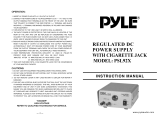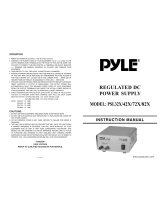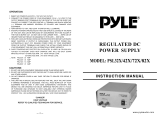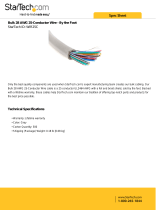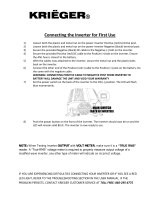Page is loading ...

2ZQHUV0DQXDO
Part Number 3506
October 27, 1998


3DFNDJLQJ0DWHULDOV
Thank you for choosing Trace Engineering products to meet your alternative-energy power needs.
We make every effort to ensure that your inverter/charger packaging includes the following materials:
Owner’s Manual;
Red\Black\Green battery terminal covers (with hardware);
AC terminal cover (with hardware);
AC Warning Decal;
Trace bumper sticker;
If any of the above listed materials are missing from your package, or if it is unsatisfactory in any
manner, please call Customer Service at (360) 435-8826 or fax this page with your comments to
(360) 435-2229.
Model Number: _____________________________________
Serial Number: _____________________________________
Purchase Date: _____________________________________
Comments: _____________________________________________________________________
_______________________________________________________________________________
_______________________________________________________________________________
_______________________________________________________________________________
_______________________________________________________________________________
_______________________________________________________________________________
Thank you for choosing Trace Engineering to meet your independent power needs. Check out our
web site at www.traceengineering.com for more information and answers to your FAQ’s.


Table of Contents
INTRODUCING THE MARINER ...........................................................................1
IMPORTANT SAFETY INSTRUCTIONS..............................................................3
G
ENERAL PRECAUTIONS....................................................................................... 3
P
ERSONAL PRECAUTIONS..................................................................................... 5
FEATURES............................................................................................................ 7
P
ROTECTION CIRCUITRY....................................................................................... 7
Automatic Low Battery Cut Out...................................................................... 7
Automatic High Battery Cut Out ..................................................................... 7
High Temperature Cut Out ............................................................................. 7
Over Current Cut Out...................................................................................... 8
Battery Type Optimization .............................................................................. 8
Charge Rate Regulation................................................................................8
Shore Power Amps Monitoring.......................................................................9
VAC Dropout................................................................................................... 9
SEARCH MODE CIRCUITRY....................................................................................9
I
MPULSE PHASE CORRECTION............................................................................. 10
T
RUE RMS VOLTAGE REGULATION..................................................................... 10
C
RYSTAL CONTROLLED TIME BASE ..................................................................... 11
S
TAND-BY BATTERY CHARGER............................................................................ 11
T
RANSFER SWITCHING SPEED ............................................................................ 11
A
UTOMATIC INVERTER TO CHARGER TRANSITION................................................. 11
UNIT IDENTIFICATION....................................................................................... 13
M
ODEL IDENTIFICATION....................................................................................... 13
S
ERIAL NUMBER................................................................................................. 14
CONTROLS & INDICATORS.............................................................................. 15
QUICK INSTALL ................................................................................................. 19
DC C
ABLING...................................................................................................... 19
AC-I
N CABLING.................................................................................................. 21
AC-O
UT CABLING...............................................................................................22
W
RAP UP ...........................................................................................................22
INSTALLATION................................................................................................... 23
S
AFETY INSTRUCTIONS....................................................................................... 23
L
OCATING THE INVERTER.................................................................................... 24
V
ENTILATION...................................................................................................... 24
M
OUNTING .........................................................................................................25
O
VERVIEW OF MARINE AC AND DC SYSTEMS ..................................................... 25
Terminology.................................................................................................. 25

Typical Marine AC and DC Electrical System...............................................26
DC CABLING.......................................................................................................27
Battery Cable Sizing......................................................................................27
Battery Cable Inductance..............................................................................27
DC Over Current Protection..........................................................................28
DC Conductors..............................................................................................29
DC Cabling Connections...............................................................................29
DC Negative Ground Cable Connection.......................................................31
Installation Procedure....................................................................................31
AC WIRING.........................................................................................................33
AC and DC Wiring Separation ......................................................................34
AC Wire Connections....................................................................................34
AC Disconnect Device...................................................................................34
Ground Fault Interrupting Outlets (GFCI’s)...................................................34
Neutral-to-Ground Switching.........................................................................35
Disabling Neutral Ground Switching .............................................................37
Installation Procedure....................................................................................39
Wrap-up.........................................................................................................41
OPERATION ........................................................................................................43
BATTERIES .........................................................................................................45
T
ERMINOLOGY ....................................................................................................45
T
YPES ................................................................................................................46
Starting Batteries...........................................................................................46
Deep-Cycle Batteries ....................................................................................46
Sealed Gel Cell .............................................................................................46
ENVIRONMENT ....................................................................................................47
Location.........................................................................................................47
Enclosures.....................................................................................................47
Temperature..................................................................................................47
BATTERY BANK SIZING........................................................................................48
Estimating Battery Requirements..................................................................48
Battery Bank Sizing Example & Worksheet..................................................49
MONTHLY MAINTENANCE.....................................................................................51
Preparation....................................................................................................51
Attire..............................................................................................................51
Tools..............................................................................................................51
Equipment .....................................................................................................52
Supplies.........................................................................................................52
Procedure......................................................................................................52
Battery Enclosure and Batteries....................................................................52
Terminals & Lugs ..........................................................................................52
Cables ...........................................................................................................53
CABLING & HOOK-UP CONFIGURATIONS...............................................................53
Parallel Connection.......................................................................................54
Series Connection.........................................................................................54

Series – Parallel Connection........................................................................ 55
THREE-STAGE BATTERY CHARGER.............................................................. 56
C
HARGING PROFILE............................................................................................ 56
C
HARGER AC REQUIREMENTS............................................................................ 58
THEORY OF INVERTER OPERATION .............................................................. 59
W
AVEFORM........................................................................................................ 59
R
EGULATION...................................................................................................... 60
APPLICATIONS .................................................................................................. 61
R
ESISTIVE LOADS............................................................................................... 61
I
NDUCTIVE LOADS............................................................................................... 61
P
ROBLEM LOADS................................................................................................ 62
OPTIONS............................................................................................................. 65
T
HE RC6 REMOTE CONTROL.............................................................................. 65
T
HE RC7 REMOTE CONTROL.............................................................................. 66
B
ATTERY TEMPERATURE SENSOR (BTS)............................................................. 67
B
ATTERY CABLES............................................................................................... 67
APPENDIX A: TROUBLESHOOTING................................................................ 69
APPENDIX B: OTHER PRODUCTS FROM TRACE ENGINEERING ............... 71
APPENDIX C: REFERENCE TABLES & GRAPHS........................................... 73
T
YPICAL POWER CONSUMPTION OF COMMON APPLIANCES...................................73
E
NGLISH TO METRIC WIRE CONVERSION CHART.................................................. 74
R
ECOMMENDED BATTERY CABLE SIZE (IN FREE AIR)............................................ 74
R
ECOMMENDED MINIMUM AC WIRE SIZES .......................................................... 75
M
AXIMUM AMPERAGE FOR CONDUCTORS UNDER 50 VOLTS AT 105ºC .................75
C
OMMON BATTERY CHARGING RATES................................................................. 76
M
ARINER CHARGING GRAPH............................................................................... 76
M
ARINER EFFICIENCY CURVE.............................................................................. 77
M
ARINER PERFORMANCE GRAPH........................................................................ 77
T
YPICAL DC INSTALLATION DIAGRAM .................................................................. 78
T
YPICAL AC INSTALLATION DIAGRAM .................................................................. 78
APPENDIX D: SPECIFICATIONS ...................................................................... 79
APPENDIX E: DIMENSIONS.............................................................................. 81
APPENDIX F: LIMITED WARRANTY................................................................. 83
APPENDIX G: LIFE SUPPORT POLICY............................................................ 87
INDEX.................................................................................................................. 89

TABLE OF FIGURES
Figure 1, Identification Placard....................................................................................... 14
Figure 2, Controls and Indicators.................................................................................... 15
Figure 3, Typical DC Wiring Diagram............................................................................ 20
Figure 4, Typical AC Wiring Diagram ............................................................................ 22
Figure 5, Power Output Versus Temperature.................................................................. 24
Figure 6, Typical AC & DC System................................................................................. 26
Figure 7, Battery to Inverter Cable Connection ............................................................. 30
Figure 8, Typical DC Wiring Diagram............................................................................ 32
Figure 9, Neutral-to-Ground Switching without external AC source .............................. 35
Figure 10, Neutral-to-Ground Switching with External AC ............................................ 36
Figure 11, Disabling Neutral-to-Ground Switching........................................................ 37
Figure 12, AC Terminal Block......................................................................................... 39
Figure 13, Typical AC Wiring Diagram .......................................................................... 40
Figure 14, Three-Stage Charging Profile........................................................................ 56
Figure 15, RC6 Remote Control Faceplate Display........................................................ 65
Figure 16 , RC7 Remote Control Faceplate..................................................................... 66
TABLE OF TABLES
Table 1, Recommended Maximum Charging Rates ........................................................... 8
Table 2, DC Cable Sizing in Free Air.............................................................................. 19
Table 3, Recommended Minimum AC Wire Sizes ............................................................ 21
Table 4, Recommended Battery Cable Size (In free air).................................................. 27
Table 5, Maximum Fuse Rating in Free Air..................................................................... 28
Table 6, Maximum Amperage for Conductors Under 50 Volts at 105ºC......................... 29
Table 7 Flexible Cable for Marine Applications.............................................................. 33
Table 8, Conductors for Marine Applications.................................................................. 33
Table 9, Recommended Minimum AC Wire Sizes ............................................................ 34
Table 10, Typical Appliance Watts................................................................................... 50
Table 11, Bulk and Float Setpoints.................................................................................. 58

,1752'8&,1*7+(0$5,1(5
,QWURGXFLQJWKH0DULQHU
The Mariner inverter/chargers are specially designed for after market installation in recreational
vehicles.
The Mariner inverter/chargers feature:
ä Easy installation
ä 2000, 2500, or 3000 watt continuous power output
ä Automatic three-stage battery charging
ä Over-current, over-temperature, and high/low battery voltage protection
ä ETL listed to UL 458 standards
ä 2-year limited warranty
ä Front-panel wiring terminals for maximum accessibility
ä Optional RC6 remote On/Off, voltmeter, ammeter, charge status and error indicator
ä Optional full-function, programmable RC7 remote control provides digital metering and user
configuration
ä Adjustable charging rate and battery type selection
ä Adjustable power-saving search mode
ä Automatic battery temperature compensation (with battery temperature sensor [BTS]
option).


,03257$176$)(7<,16758&7,216
,03257 $176$)(7<,16758&7,216
SAVE THESE INSTRUCTIONS
This manual contains important safety and operating instructions as prescribed by UL specifications
for inverters used in marine applications. This manual covers inverters and inverter/chargers models:
M2012, M2512, and M3012 Mariner inverter/chargers. The entire Mariner Series of inverters is ETL
listed to the general UL specification #458.
*HQHUDO3UHFDXWLRQV
1.
Before using the inverter/charger, read all instructions and cautionary markings on (1) the
inverter/charger, (2) the batteries, and (3) all appropriate sections of this instruction manual.
2.
CAUTION - To reduce risk of injury, charge only deep-cycle lead acid, lead antimony, lead
calcium, gel cell, or absorbed mat type rechargeable batteries. Other types of batteries may
burst, causing personal injury and damage.
3.
Do not expose inverter/charger to rain, snow or liquids of any type. The inverter is designed
for interior mounting only. Protect the inverter from splashing when used in marine
applications.
4.
Do not disassemble the inverter/charger; take it to a qualified Trace Engineering Service
Center when service or repair is required. Incorrect re-assembly may result in a risk of
electric shock or fire.
5.
To reduce risk of electric shock, disconnect all wiring before attempting any maintenance or
cleaning. Turning off the inverter will not reduce this risk.
6.
WARNING - RISK OF EXPLOSIVE GASES
WORKING IN VICINITY OF A LEAD ACID BATTERY MAY BE DANGEROUS.
BATTERIES GENERATE EXPLOSIVE GASES DURING NORMAL OPERATION. FOR
THIS REASON, IT IS OF UTMOST IMPORTANCE THAT EACH TIME BEFORE
SERVICING EQUIPMENT IN THE VINCINTITY OF THE BATTERY, YOU READ THIS
MANUAL AND FOLLOW THE INSTRUCTIONS EXACTLY.
Provide ventilation to outdoors from the battery compartment. The battery enclosure should
be designed to prevent accumulation and concentration of hydrogen gas in “pockets” at the
top of the compartment. Vent the battery compartment from the highest point. A sloped lid
can also be used to direct the flow to the vent opening location.
To reduce the risk of battery explosion, follow these instructions and those published by
battery manufacturer and any manufacturer of any equipment you intend to use in the
vicinity of batteries. Review cautionary markings on these products and all other products
being used.

,03257$176$)(7<,16758&7,216
7. No terminals or lugs are required for hook-up of the AC wiring. AC wiring must be no less than
10 AWG (5.3 mm
2
) copper wire and rated for 75
°
C or higher. Battery cables must be rated for
75
°
C or higher and should be no less than the minimum size wire recommended by this manual.
Crimped and sealed copper ring terminal lugs with a 5/16” hole should be used to connect the
battery cables to the DC terminals of the inverter/charger. Soldered and crimped cable lugs are
also acceptable. Solder shall not be the sole means of mechanical connection in any circuit
[ABYC E-9.16(k)] unless the solder contact length exceeds 1.5 times the diameter of the
conductor. See section
Batteries and Chargers
for correct battery cable size and length for your
application.
8. Torque all AC wiring connections to 15-20 inch-pounds. Torque all DC cable connections to 10-
12 foot-pounds.
9. CAUTION: To reduce the risk of fire, use only input circuits provided with the correct ampere
branch circuit protection in accordance with the National Electric Code, ANSI/ NFPA70
10. Use the correct tools to make AC/DC wiring connections: wire strippers, ½” (13mm) open-end
wrench or socket, Phillips screw driver #2, and ¼” flat blade screwdriver (6mm).
11. This inverter/charger should be used with a battery supply of 12-volts DC nominal voltage.
12. Do not install this inverter/charger on or near flammable materials (plywood, chemicals, gasoline,
etc.).
13. The unit is designed for mounting on a flat surface only. Do not mount on a bulkhead or hang
inverted.
14. No AC or DC disconnects are provided as an integral part of this inverter. Both AC and DC
disconnects must be provided as part of the system installation. See
Installation
section on Page
23 of this manual.
15. No overcurrent protection for the battery supply is provided as an integral part of this inverter.
Overcurrent protection of the battery cables must be provided as part of the system installation.
See
Installation
section of this manual.
16. No overcurrent protection for the AC output wiring is provided as an integral part of this inverter.
Over-current protection of the AC output wiring must be provided as part of the system
installation. See the
Installation
section of this manual.
17. DC GROUNDING INSTRUCTIONS - This inverter/charger should be connected to a grounded,
permanent wiring system. For most installations, the negative battery conductor should be
bonded to the vessel safety-grounding conductor (green wire) as per ABYC standard E-8.5 and
E-9.20. Connection of the green DC negative ground terminal on the side of the inverter to the
DC load center negative bus (connected in turn to the engine negative terminal) will create the
battery negative to vessel safety ground. All installations should comply with Federal
regulations.
Connect and disconnect DC output connections only after setting the inverter switches to the Off
position and removing AC shorepower cord from the shorepower connector, or after opening the
AC disconnect device.

,03257$176$)(7<,16758&7,216
18. EXTERNAL CONNECTIONS TO THE UNIT SHALL COMPLY WITH THE UNITED STATES
COAST GUARD ELECTRICAL REGULATIONS (33 CFR 183, SUB PART I).
19. AC GROUNDING INSTRUCTIONS – The inverter/charger includes neutral-to-ground switching
for the AC electrical system. The AC system in marine installations must have the neutral
physically isolated from the ground throughout the load distribution powered by the inverter.
3 HUVRQDO3UHFDXWLRQV
1. Someone should be within range of your voice to come to your aid when you work near
batteries.
2. Have plenty of fresh water and soap nearby in the event that battery acid contacts skin,
clothing, or eyes.
3. Wear complete eye protection and clothing protection. Avoid touching eyes while working
near batteries. Wash your hands when done.
4. If battery acid contacts skin or clothing, wash immediately with soap and water. If acid
enters eyes, immediately flood eyes with running cool water for at least 15 minutes and get
medical attention immediately.
5. Baking soda neutralizes lead acid battery electrolyte. Vinegar neutralizes spilled NiCad
and NiFe battery electrolyte. Keep a supply on hand in the area of the batteries.
6. NEVER smoke or allow a spark or flame in vicinity of a battery or generator.
7. Be extra cautious when working with metal tools on and around batteries. It could short-
circuit the batteries or other electrical parts, producing a spark that could cause an
explosion.
8. Remove personal metal items such as rings, bracelets, necklaces and watches when
working with a battery. A battery can produce a short-circuit current high enough to weld a
ring, or the like, to metal causing severe burns.
9. Never attempt to charge a frozen battery.
10. If a remote or automatic generator-start system is used, disable the automatic starting
circuit, and/or disconnect the generator from its starting battery while servicing to prevent
accidental starting during servicing.
11. If necessary to remove any batteries, always remove the grounded terminal from the
battery first. Make sure all accessories are off, so as not to cause an arc.
12. Be sure area around battery is well ventilated.

,03257$176$)(7<,16758&7,216
13. Clean battery terminals. Be careful to keep corrosion from coming in contact with eyes.
14. Study all battery manufacturer’s specific precautions (such as removing or not removing
cell caps while charging) and recommended rates of charge.
15. Add ONLY distilled water in each cell until battery acid reaches level specified by battery
manufacturer. This helps purge excessive gas from cells. Do not overfill. For a battery
without cell caps, carefully follow manufacturer’s recharging instructions.

)($785(6
)HDWXUHV
All Mariner inverters include extensive protection circuitry, Search Sense Mode, Impulse Phase
Correction, true RMS voltage regulation, crystal-controlled timing, three-stage battery charging, and
an internal AC transfer relay.
3URWHFWLRQ&LUFXLWU\
The inverter is protected from high-battery voltage, low-battery voltage, over-heating, and over-
current conditions. When the inverter senses one of these situations, it will protect itself by
disconnecting from the loads, and will signal an error condition by a red flashing of the LED indicator.
The low-battery cutout, high-battery shut down, and over-temperature protection circuitry resets
automatically. If an over-current condition continues for more than 20 seconds, the inverter will
shutdown and must be reset with the power button. If the error condition is remedied before the 20-
second period has elapsed, the inverter will automatically reset.
Automatic Low Battery Cut Out
The Mariner inverter/charger protects your batteries from damage caused by over-discharging by
automatically shutting itself off when battery voltage falls to a preset level. This feature is called the
Low Battery Cut Out (
Auto LBCO)
. Your Mariner inverter/charger comes from the factory with the
Auto LBCO
enabled; LBCO voltage is set at 11.1 volts. You can adjust the cutoff voltage to 8.5 volts
(
Auto LBCO
disabled) using the optional RC7 remote control.
See The RC7 Remote Control
section
on Page 66 for more information about the configuring LBCO.
Automatic High Battery Cut Out
When battery voltage rises above 15.6 volts, the inverter shuts down to protect electronics that may
be operating off of it (high battery voltage results in high AC peak voltage). The inverter automatically
resumes operating when battery voltage drops below 15.6 volts. High battery voltage can occur
only
through using an unregulated charging source, such as an unregulated solar or other DC generator
or alternator. To remedy this problem, disconnect any external charging sources.
High Temperature Cut Out
The inverter is protected from overheating due to excessive loading or charging. When the internal
temperature of the inverter exceeds its design limits, the inverter will disconnect itself and shut down.
After a sufficient cooling period, the inverter will automatically reset and resume operation. Some
causes of high internal temperatures include excessive loading, high ambient temperatures,
inadequate ventilation, and an inoperative cooling fan. To remedy, reduce loads or reduce ambient
temperatures by relocating, insulating, and/or ventilating the inverter enclosure (See the section on
Page 23 for more information).

)($785(6
Over Current Cut Out
Mariner inverter/chargers are protected from over-current conditions. When the load being run
demands more current than the inverter can safely supply, the inverter will momentarily shutdown,
turn off if it encounters an over-current condition for approximately 20 seconds (a prolonged short-
circuit) or if the AC output is connected to another AC power source (shorepower or generator).
Battery Type Optimization
Mariner inverter/chargers are designed to prevent damage to and extend the useful life of your
batteries by regulating the charging voltage and duration. To do this, the inverter/charger must be
configured for the type of batteries in the system. The Mariner is pre-configured for optimum
charging of gel-cell type batteries at 14.1 volts in bulk charging mode, and 13.5 volts in float charging
mode. For liquid lead-acid batteries, you can reset the Mariner using the RC7 remote control to bulk
charge at 14.5 volts and float charge at 13.4 volts. For a complete discussion of batteries and battery
charging techniques, see the
Batteries
and the
Three-Stage Battery Charger
sections of this manual.
Charge Rate Regulation
Batteries can overheat if the charge rate is too high. The Mariner inverter/charger protects your
batteries by enabling you to limit the charge rate using the RC7 remote control. The charge rate is
set at the factory to 100% of maximum, which may be up to 140 amps depending upon the model
you have purchased (see
Appendix D: Specifications
to determine the maximum possible charge
rate for your model). For smaller battery banks, this may be too high.
The highest charge rate recommended is determined by dividing the battery bank’s amp hour
capacity by a factor of three or five (3 for gel cell - 5 for lead acid).
Table 1, Recommended Maximum Charging Rates
Battery Capacity in Amphours Recommended Maximum Charge Rate in Amps
Gel Cell Lead-Acid Liquid Lead-Acid
125 40 25
250 20 50
500 140 100
Setting the charge rate at the highest recommended level is best when the objective is to charge the
batteries as quickly as possible. A much lower setting can be used in installations where AC power is
typically available for periods of several hours. There is more than sufficient time for a 400-amphour
battery bank to be recharged in 24 hours at a 25-amp setting.
Example: 25 amps X 24 hours = 600 amp/hrs.

)($785(6
Caution: Excessively high charge rates can overheat a battery. If battery bank capacity is low, set
the battery charge rate to the minimum setting.
Shore Power Amps Monitoring
Mariner models monitor the current drawn by the built-in charger and any AC loads. These current
requirements may exceed the amperage rating of the shore power circuit breaker. To prevent
unnecessary tripping of this circuit breaker, the inverter limits the current draw to a maximum
between five and 30 amps, set by using the RC7 remote control. Shore power amps is pre-set at the
factory to a maximum of 25 amps.
VAC Dropout
Mariner model inverter/chargers monitor the voltage of the AC power passing through to the charger
and AC loads. When AC voltage falls below a pre-set level, the inverter automatically transfers from
AC power to DC power. This dropout voltage is factory pre-set to 40 volts. You can re-set this
voltage from 40 to 100 volts using the RC7 remote control. Using a lower voltage results in less
frequent transfers from AC to DC power, but may cause undesirable operation of some AC loads,
including brown-outs and damage.
6HDUFK0RGH&L UFXLWU\
Mariner inverters feature circuitry that minimizes power drain by reducing the inverter’s output to
small test pulses when there is no load connected to the inverter. These pulses are used to detect
the presence of a load. When a load is detected the inverter’s output goes to full voltage. The
sensitivity of the detection threshold is adjustable from about five watts to 40 watts using the RC7
remote control. This feature is defeated (turned Off) at the factory and can only be activated using
the RC7 remote control.
Example: With the threshold set to detect a 40 watt load, a 50 watt load will bring the unit to full
output voltage. However, a 30-watt load will leave the inverter in its energy saving Search Mode. If
sensitivity is increased (by setting the control to 10), a 20 watt load will bring the inverter out of the
search mode, while a five-watt load will not.
When in the search mode, the green Power LED will blink. At full output voltage, the LED will remain
lit. When the inverter is used as an un-interruptable power supply, the search mode function should
be defeated. A neon nightlight can be used as a good indicator to determine if the inverter is in
search mode. Simply plug the light into any AC outlet connected to the inverter’s output. When the
inverter is in the search mode the light will blink. If the inverter is running a load, the light will be on
continuously.
Exceptions: (Murphy’s Law) Unfortunately, things don’t always work the way the manual says they
will.
Example A: If the threshold is set to detect a 40-watt load and a 30-watt incandescent light is turned
on, the inverter will detect the light. The light is a bigger load than 40 watts when its filaments are

)($785(6
cold. When the light gets hot it becomes a 30-watt load. Since this is below threshold of 40-watts, the
inverter will not detect it and the light will go out. This will cause the light to cycle repeatedly.
Example B: If the threshold is set to detect a 30-watt load and a 40-watt fluorescent light is turned
on, the inverter will not detect the light. The light presents a smaller load than 30 watts until the gas in
the fluorescent tube ionizes.
Example C: There are some appliances that draw power even though they are turned off. TVs with
instant on circuitry microwave ovens with digital displays and VCRs are examples. These loads
present a dilemma. If the sensitivity is set higher than the combination of these loads, then an
auxiliary load must be used to bring the inverter out of the search mode before the appliances can be
turned on. If the sensitivity is set lower than this combination of loads, the loads will be left on and will
put an additional drain on the batteries. Three such 15-watt loads would amount to an additional 90
amp/hours per 24 hours in a 12 VDC system.
One solution is to turn these items off at the wall. Use an extension cord with a rocker switch, a
switch at the outlet, or the appropriate circuit breaker. Another solution might be to place all these
phantom loads on a separate circuit with its own disconnect.
This circuit determines how much power the inverter draws when there are no loads. The inverter’s
transition from the no load state to full output voltage is fast, eliminating delays when operating
devices such as hand tools. Additionally, the threshold sensitivity of the search mode is user
adjustable (with the optional RC7 remote control), and it may be disabled.
,PSXOVH3KDVH&R UUHFWLRQ
This circuitry improves the shape of the output waveform while the inverter is running reactive loads.
It allows the inverter to closely duplicate the characteristics of standard public power. With this
design approach, the limitations of the modified sine wave format are largely overcome. The primary
benefit is realized when the inverter is running induction motors and fluorescent lights. Induction
motors are commonly used to run drill presses, fans, and bandsaws.
When an inductive load is driven, it tries to return a large portion of the energy that it has received.
This returned energy can be thought of as going ‘backwards’ through the household wiring to the
motor, giving the motor an extra push and making it run smoothly. Impulse phase correction
provides a similar path for this ‘backwards’ energy. The Mariner line of inverter/chargers will run
small motors at full speed, start larger ones, and run both efficiently.
7 UXH5069 ROWDJH5 HJXODWLRQ
With battery voltages from 11 to 15 VDC and power levels up to the continuous power rating, the
inverter will deliver true RMS regulated power. This insures that while battery voltages and power
levels change, the inverter will deliver the correct output voltage.

)($785(6
&U\VWDO&RQWUROOHG7LP H%DVH
Proper frequency regulation is assured with the use of a crystal. Battery voltage and power have no
effect on the inverter’s operating frequency.
6WDQGE\%D WWHU\&KDUJHU
The Stand-by feature includes an internal battery charger and automatic transfer relay. This allows
the unit to operate as a battery charger or an inverter (but not at the same time). An external source
of AC power (i.e. shore power or generator) must be supplied to the inverter’s AC input to allow it to
operate as a battery charger. When the unit is operating as a charger its AC output is powered by
the external AC source. See the
Three-Stage Battery Charger
section beginning on Page 56 for an
in-depth description of this charger.
7 UDQVIHU6ZLWFKLQJ6SHHG
While this inverter is not designed specifically to operate as an un-interruptable power supply (UPS),
its transfer time is normally fast enough to hold up computers in the event of a power outage.
Transfer time is a maximum of 32 milliseconds (two 60Hz AC cycles). Success as UPS will vary with
computer models, and cannot be guaranteed. If this is an issue, buy a small, dedicated UPS for the
specific application.
$XWRPD WLF,Q YHUWHUWR& KDUJHU7 UDQVLWLRQ
The inverter automatically becomes a battery charger whenever AC power is supplied to its AC
inputs. There is a minimum 20-second time delay from the time the inverter senses that AC is
present at its input to when the transfer is made. This delay is built in to provide time for a generator
to spin-up to a stable voltage and avoid relay chattering. The inverter’s AC input is internally
connected to the inverter’s AC output while in the battery charger mode. The maximum power that
can be handled by the inverter’s internal wiring and transfer relay is 30 amps.

/








